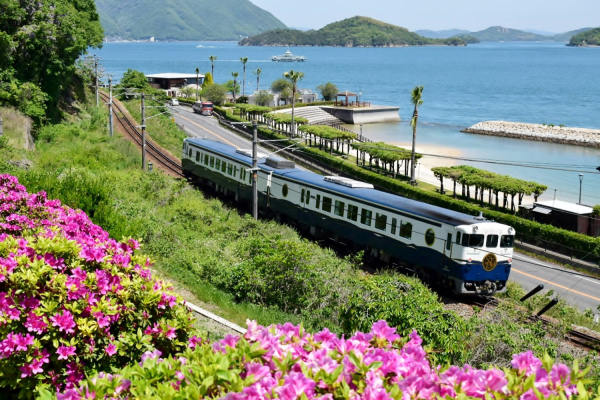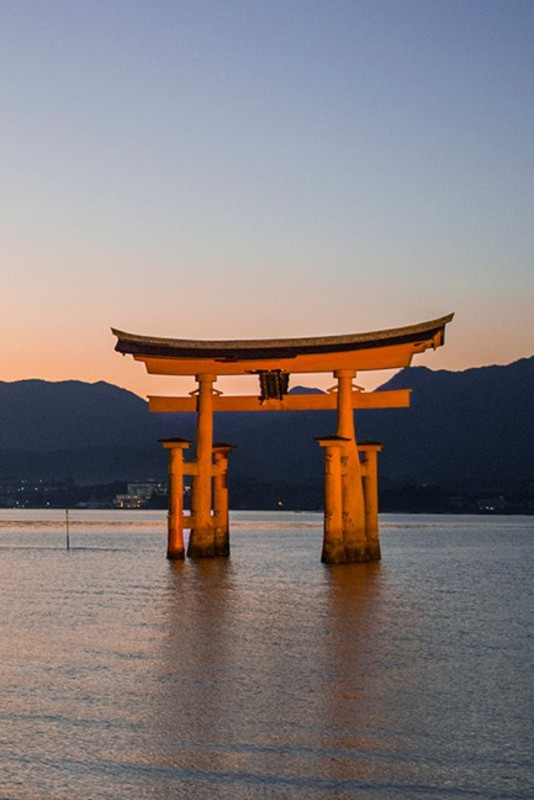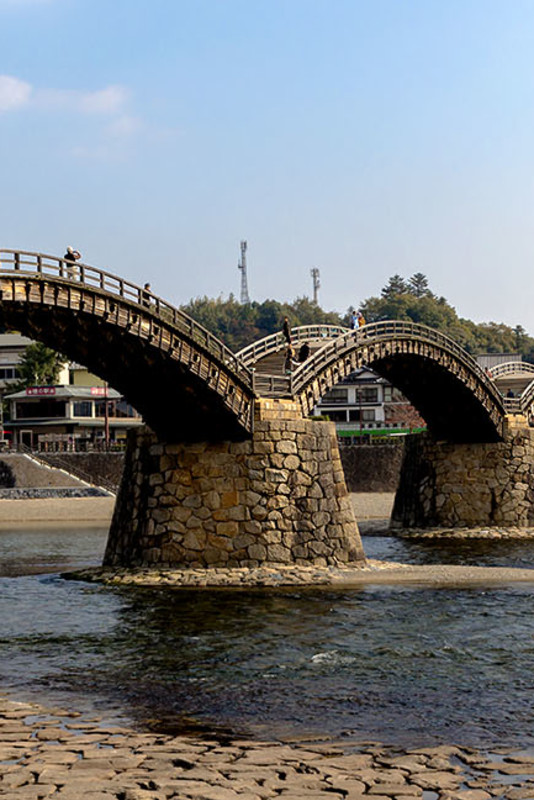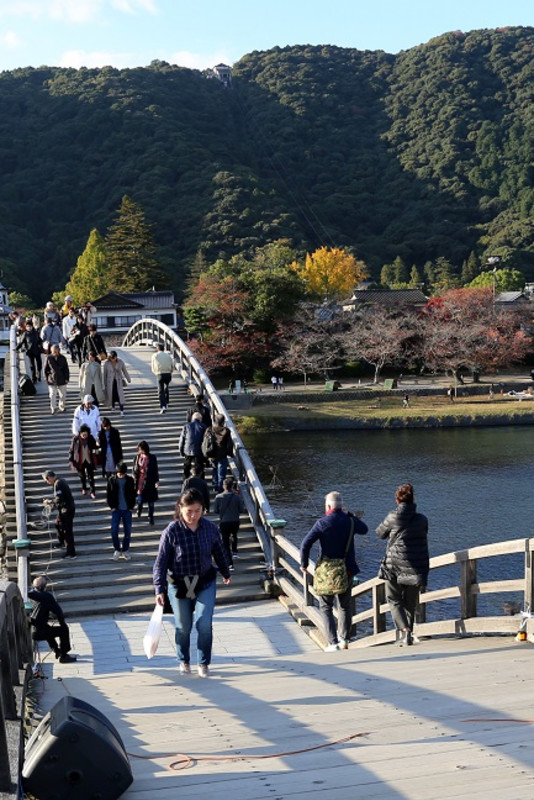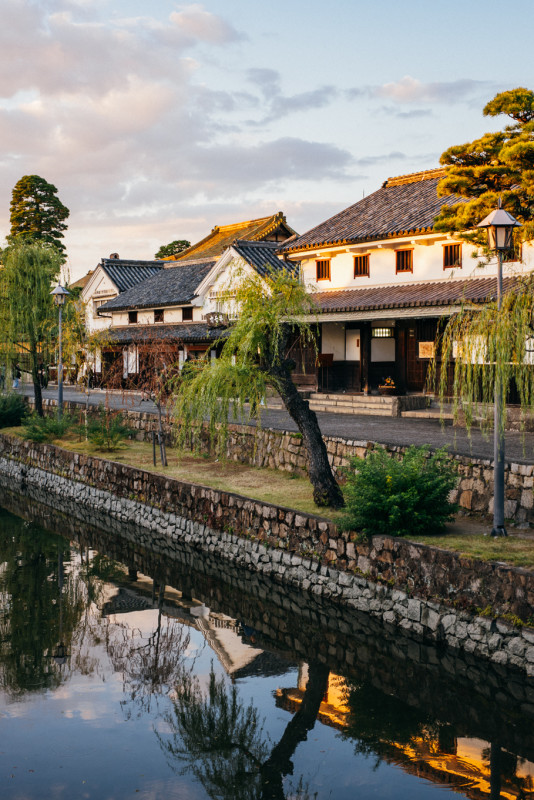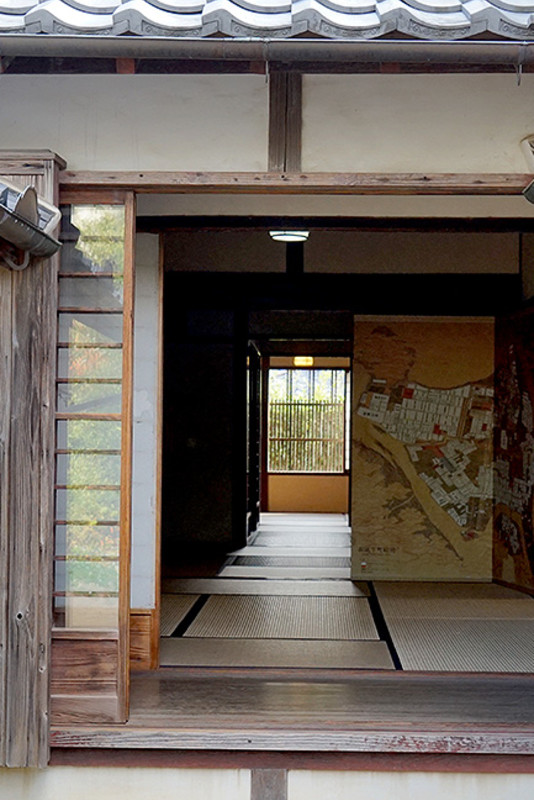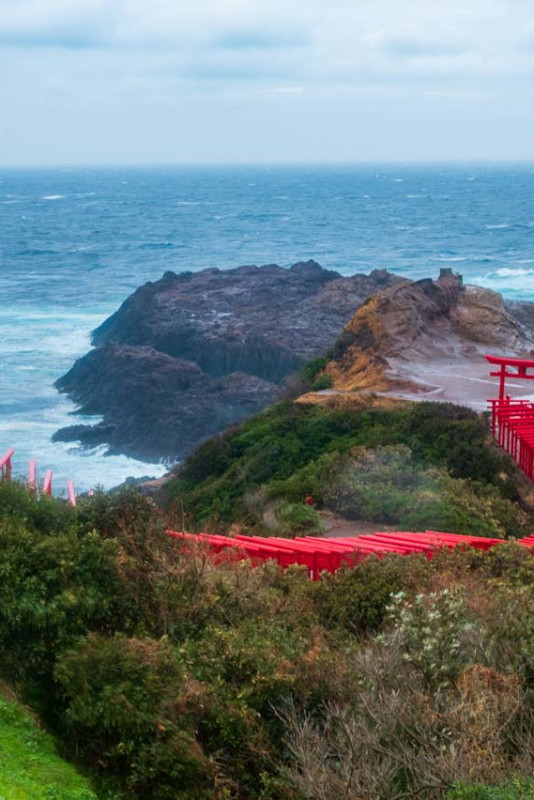Itineraries
A Foodie's Journey Through the History of Hiroshima and Yamaguchi

Enjoy sublime seafood and local delicacies on this four-day itinerary through Hiroshima and Yamaguchi. We head west along the Seto Inland Sea coast from the port town of Onomichi to Hiroshima, before hitting the hot spring retreats of Yamaguchi Prefecture by way of Iwakuni's grand Kintaikyo bridge and Hagi on the Japan Sea coast.
- Day 1
- Onomichi and Hiroshima
Accommodation: Hilton Hiroshima
A short taxi ride from Hiroshima Station and within walking distance of Hiroshima Peace Memorial Park, the Hilton Hiroshima is the perfect place to base yourself during a visit to Hiroshima. With well-appointed, modern rooms, and excellent guest facilities, the Hilton Hiroshima is a luxurious refuge in which to relax, recharge and ready yourself to explore the city or head to your next destination.
Four restaurants serve Japanese and international cuisine using locally sourced ingredients. In the Executive Lounge on the 22nd floor, guests can enjoy evening cocktails and light snacks, as well as a variety of beverages, while taking in the views over islands of the Seto Inland Sea and surrounding mountains.
A guest relations officer is also on hand to provide assistance with sightseeing and restaurant reservations. Take the relaxation up another level with a visit to the luxurious Spa by L’OCCITANE.
URL: Hilton Hiroshima
Onomichi
Onomichi is a port town with a history that stretches back to the middle ages. Streets so narrow they hardly deserve the name criss-cross the steep mountainside that rises from the waterfront are lined with tumble-down houses and there seem to be as many cats in residence as people. It is a delightful place to spend a few hours and a frequent cable car service takes some of the strain out of exploring the town.
Senkoji Temple
Founded in 806, Senkoji Temple is located on a hilltop in Senkoji Park and offers visitors a lovely view of downtown Onomichi and of the Seto Inland Sea. While visitors can walk up to the temple, there is also a ropeway that is available for those who don’t want to walk uphill. The views from the ropeway are really nice also, especially the view of Senkoji Temple as the ropeway passes over it.
Onomichi Temple Walk
There are 25 temples within walking distance of each other and many visitors come to Onomichi to do the temple walk. Though possible to complete in a couple of hours, if you want to take your time, and look at other spots in the area, it could take half a day. If time is not on your side though, be sure to try to visit Senkoji, Tenneiji, and Jodoji, the three most famous ones. Tenneiji has a beautiful five-storied pagoda, and from behind the pagoda visitors can enjoy a beautiful view. Jodoji is said to be one of the oldest temples in the Chugoku region, and the main hall of the temple and the pagoda are listed as national treasures.
Cat Alley (Neko no Hosomichi)
Stroll down this 200 meters long narrow path that is full of stone cat designs, tiles with cats painted on them, and real cats walking around and lounging. There is even a maneki-neko (lucky cat) museum containing a collection of over 3,000 lucky cats.
Onomichi Ramen
When in Onomichi, one must try Onomichi Ramen. Known for their soy sauce soup, their broth is typically made with chicken bones, fish caught in the Seto Inland Sea, and some soy sauce. There are bits of pork back fat in the broth also, and there is thinly sliced pork on top like you would find in ramen in other areas. Unlike typical ramen noodles, the noodles are thin and flat, which is said to soak up the broth better than the typical ramen noodles.
Onomichi Brewery
Founded by a couple from Tokyo, Onomichi Brewery is located in a renovated old storehouse that was originally built in 1894. They offer a nice variety of freshly brewed beers and some unusual flavors using ingredients that are sourced locally. One example is the Iwashjima Tomato Weizen, in which they use tomatoes from a couple of local farms. Whatever you decide to try, this is a great spot to take a break from all of the walking and enjoy a fresh, cold beer.
Travel: Onomichi to Hiroshima
・Take the local train to Mihara Station or Fukuyama Station where you transfer to the Shinkansen to Hiroshima Station. (Approx 1 hour)
・Alternatively, take a 10-minute taxi ride from Onomichi Station to Shin-Onomichi Station where you can take the Shinkansen direct to Hiroshima Station. (Approx 40 minutes on the train)
Hiroshima Peace Memorial Park
The beautiful Peace Memorial Park, dedicated to the memories of the victims who were affected by the atomic bomb that was dropped on Hiroshima in 1945, sits in the center of Hiroshima City. Within the park visitors will find the UNESCO World Heritage A-Bomb Dome, the Children’s Peace Monument and the Hiroshima Peace Memorial Museum. There are many other poignant monuments and memorials within the park so if time allows we recommend walking around to other parts of the park also.
Hiroshima’s Soul Food, Okonomiyaki
Okonomiyaki is the soul food of Hiroshima. It’s like a large savory pancake that is stuffed with cabbage and soba noodles or udon noodles, sandwiched by some thinly sliced pork (can be ordered without pork), a crepe, and a fried egg. A delicious sauce is brushed on top and then it is typically eaten right off the grill with a metal spatula. There are literally hundreds of great spots in Hiroshima, but try to sit at the counter if you can. Watching them put this famous Hiroshima dish together is part of the fun.
Eki Nishi
A great area to find some good food and drinks, Eki Nishi is located near Hiroshima Station and there are many eateries to choose from. Packed within the few narrow streets you will find yakitori joints, okonomiyaki shops, oyster bars and many other spots in which to rub shoulders with the locals while munching on some light eats while sampling locals.
Accommodation: Hilton Hiroshima
A short taxi ride from Hiroshima Station and within walking distance of Hiroshima Peace Memorial Park, the Hilton Hiroshima is the perfect place to base yourself during a visit to Hiroshima. With well-appointed, modern rooms, and excellent guest facilities, the Hilton Hiroshima is a luxurious refuge in which to relax, recharge and ready yourself to explore the city or head to your next destination.
Four restaurants serve Japanese and international cuisine using locally sourced ingredients. In the Executive Lounge on the 22nd floor, guests can enjoy evening cocktails and light snacks, as well as a variety of beverages, while taking in the views over islands of the Seto Inland Sea and surrounding mountains.
A guest relations officer is also on hand to provide assistance with sightseeing and restaurant reservations. Take the relaxation up another level with a visit to the luxurious Spa by L’OCCITANE.
URL: Hilton Hiroshima
- Day 2
- Iwakuni and Yamaguchi
Travel: Hiroshima to Iwakuni
・Direct buses to Kintaikyo Bridge, Iwakuni leave from Hiroshima Bus Center (Approx 55 minutes)
・Alternatively take a local train from Hiroshima to Iwakuni (Approx 50 minutes) and travel to Kintaikyo Bridge by taxi (Approx 12 minutes) or local bus (Approx 30 minutes)
Kintaikyo Bridge
A magnificent wooden pedestrian bridge with five arches, Kintaikyo Bridge is the main attraction in Iwakuni. The original bridge was built in 1673, but the first few bridges that were built were heavily damaged or completely washed away during heavy rains. The people decided to build the wooden bridge on stone pillars and they finally had a bridge that could withstand the heavy rains. It lasted over 200 years before a super typhoon came through in 1950 and damaged the bridge. To this day, Iwakuni has preserved the process of building the bridge in its original form and all restoration projects are done following the guidelines of the original build.
Kikko Park and Iwakuni Castle
Located next to Kintaikyo Bridge, Kikko Park offers a place to sit and take a break or walk around and enjoy the greenery. On the way to the park is a famous soft serve spot, Sasakiya Kojiro Shoten, where you can grab a cone to enjoy. Also located in the park area is Iroya Gallery, a great spot to view works from local artists and purchase some unique souvenirs or gifts.
Renkon (Lotus Root)
Iwakuni Sushi
Iwakuni Sushi is similar to chirashi-zushi, but it is pressed into a wooden mold. It contains Iwakuni lotus root and fresh fish from the Seto Inland Sea for the toppings. This famous local dish can also be sampled at Honke Matsugane. Hirasei is one of the restaurants around Kintaikyo Bridge that offer Iwakuni Sushi on their menu.
Before you leave Iwakuni
Drop in at Murashige Sake Brewery, a short walk from Shin-Iwakuni Station, before you head to Yamaguchi. As well as marveling at the world’s biggest sugi-dama (the cedar balls that you see hanging in front of sake breweries and shops), you can enjoy sake tastings, try sweets made from sake and sake lees and pick up unique souvenirs.
Travel: Iwakuni to Yamaguchi
・Take the Shinkansen from Shin-Iwakuni Station to Shin-Yamaguchi Station (Approx 30 minutes)
・Take a local train from Shin-Yamaguchi Station to Yamaguchi Station (Approx 25 minutes)
Rurikoji Temple
Rurikoji Temple is most famous for its stunning five-storied pagoda. The five storied pagoda is recognized as a national treasure and is ranked among the top three greatest pagodas in Japan. A large restoration project is estimated to be completed in autumn 2025.
Kawara “Roof Tile” Soba
A specialty of Yamaguchi Prefecture, Kawara Soba is green tea soba served on a hot roof tile (kawara) with beef, thinly sliced egg, seaweed, grated daikon, and slices of lemon on top. It is served with a broth to dip the noodles in before eating. Kawara Soba Yanagiya Yamaguchi on the Ichinosaka River is a popular spot to enjoy this tasty dish in Yamaguchi City.
Travel: Yamaguchi to Yuda Onsen
・Take a local train from Yamaguchi Station to Yuda Onsen Station (Less than 5 minutes)
・By taxi (Approx 10 minutes)
Accommodation: Matsudaya Hotel
A hotel that has been around for over 300 years, when you step into Matsudaya Hotel you will feel like you have stepped back in time. The main building was built in the Taisho period and guests who stay in this building are also able to see the garden from their room. Meals are served in the guest rooms, providing privacy as guests dine on exquisitely prepared dishes using seasonal and local ingredients. A stay at this historical property is a must when visiting Yamaguchi City and the Yuda Onsen area.
URL: https://www.matsudayahotel.co.jp
- Day 3
- Hagi and Nagato Yumoto Onsen
Travel: Yuda Onsen to Hagi
・Buses leave for Hagi from Yamaguchi Station and Shin-Yamaguchi Station, which can be reached by local train from Yuda Onsen Station. It is recommended to check in advance to find the best option for your departure time. The total journey time is usually approximately 2 hours.
・By car it takes less than an hour.
Hagi Castle Town and Hagi-yaki Pottery
Hagi Castle Town gives visitors a feeling like they have stepped back in time. View some well-preserved traditional samurai houses and some traditional earthen walls as you walk around. Pottery lovers will also find pottery shops throughout the castle town area. Hagi-yaki is a very famous type of pottery in Japan and has been around since the early 1600s. It is known for its earthy texture that comes from the type of clay that is sourced locally.
Tokoji Temple
Tokoji Temple was built by the Mori Clan in 1691. Hundreds of stone lanterns that were donated by vassals of the clan stand in front of the tombs make for an impressive sight. Starting with the third generation, the odd-numbered generations of Mori lords and their families were buried here. Even-numbered lords are buried separately at Daishoin Temple. This style of burial is according to a Chines custom and Chinese influence is also evident in the temple's design, particularly the in gateway and main hall.
Hagi Seamart
Hagi is known for really fresh seafood and Hagi Seamart is a great spot to try it. Inside visitors will find a small fish market, gift shop, and a few restaurants. The restaurants here prepare reasonably priced dishes made with seafood caught that morning.
URL: http://seamart.axis.or.jp/en/index.html
Travel: Hagi to Nagato Yumoto Onsen
・Take the local train from Hagi to Nagato -Yumoto Station (Approx 35 minutes)
・Take a bus from Nagato Station to Nagato Yumoto Onsen (Approx 15 minutes)
・By car approx 30 minutes
Nagato Yumoto Onsen
Yumoto Onsen is a small onsen town located in rural Nagato. The area by the river was recently renovated and now there is a large parking lot and a large public bath for those who wish to enjoy the hot springs, but maybe aren’t staying in the area. Visitors can listen to the river flow as they stroll up and down the walking paths, or stick their feet in the water and cool off for a little bit. There are also a few cafes and shops in the area.
Accommodation: KAI Nagato
A beautiful Japanese style hot spring hotel that offers some rooms with private hot springs and great views, KAI Nagato is the newest hotel in Yumoto Onsen. The rooms are decorated with paper craft, lacquer works, ceramics, and glass that all showcase crafts that Yamaguchi Prefecture is known for. Dinner is kaiseki style with seasonal dishes prepared using local ingredients and is served in a semi private space. Guests will definitely want to partake in the onsen during their stay here and there are two baths for hotel guests. One is indoor and one is outdoor.
URL: https://hoshinoresorts.com/en/hotels/kainagato
- Day 4
- Nagato and Shimonoseki
Travel note
Although a local train makes the scenic journey along the Japan Sea Coast between Nagato and Shimonoseki in around 2 hours, to enjoy this beautiful area to the fullest we recommend renting a car or engaging the services of a charter taxi.
Omijima and the “Alps of the Sea”
Before heading west towards Shimonoseki, check out the scenic island of Omijima. Part of the Kita-Nagato Quasi-National Park, it is protected for its natural beauty and a great hiking path offers breathtaking views of the coastline, rocks that have been carved by the ocean, and some beautiful cliffs. It’s easy to see how it got the nickname, “Alps of the Sea”, when hiking along the coastline.
To get an even closer look at this dramatic scenery, take one of the Omishima sightseeing boat tours that depart from Senzaki Fishing Port.
Senza Kitchen
This roadside station in Nagato is a great spot to stop for lunch or a snack. Senza Kitchen is located near Omijima Island and inside you will find a restaurant that serves fresh seafood, a coffee stand, a little farmers market, and more. For visitors who have children, the Nagato Toy Museum is located right by Senz a Kitchen and is really a large indoor play area with different stations for children to play in.
URL: https://www.visit-jy.com/en/spots/17856
Motonosumi Shrine
If time allows, a visit to Motonosumi Shrine is a must. The views from this shrine are pretty amazing and the 123 red torii gates leading to a cliff make for some beautiful photos. The offering box is also unique here. It sits on top of the large torii gate and legend has it that the wishes will come true for those who are able to throw the coins up into the box.
If driving from Nagato to Shimonoseki, we recommend stopping by Tsunoshima Bridge. The bridge is 1780 meters in length and connects Tsunoshima Island to mainland Japan. The design of the bridge is beautiful and this is another spot that offers some great scenery.
Shimonoseki
On the western tip of the island of Honshu, Shimonoseki sits on the Kanmon Straits, across which an impressive bridge stretches to the island Kyushu. These straits have been an important crossing point since ancient times, connecting the Sea of Japan and the Seto Inland Sea.
It was in the Kanmon Straits that separate Shimonoseki from the island of Kyushu that the Battle of Dan-no-ura was fought in 1185, a pivotal battle in the struggle between the two great samurai houses, the Taira (Heike) and Minamoto clans. In the face of a decisive defeat, many of the Taira forces committed suicide, including the child emperor Antoku, whose tomb is found at nearby Akama Shrine. Two impressive statues depicting the clan leaders stand in Mimosusogawa Park – Taira Tomomori, tied to an anchor before plunging himself into the sea, and Minamoto no Yoshitsune making his legendary “eight-boat leap”.
Karato Market
Fresh seafood lovers will enjoy walking around Karato Fish Market. Local fishermen have been selling their freshly caught fish here since 1909, when it was a street market, so it’s a great spot to grab some really fresh sashimi bowls or sushi for some very reasonable prices. Shimonoseki is famous for its fugu (blowfish) and the Karato Market is also a good spot to give this fish a try.
Be on the lookout for fugu (pufferfish) sashimi, a local specialty and a must-try in Shimonoseki. Fugu is notorious for the neurotoxins found in parts of the fish that need to be carefully removed before eating. Sale of fugu is tightly controlled and only those with a special license are allowed to prepare it. More fugu is landed at Shimonoseki than any other port in Japan and the fugu sashimi served by vendors at Karato Fish Market is not only super fresh, but doesn’t come at the premium prices you will find elsewhere in Japan.
If raw fish makes you nervous, try Fugu karaage (deep fried pufferfish) from one of the vendors among the souvenir shops along Kanmon Wharf. For a more refined Fugu dining experience with a great view of the Kaimon Straits Bridge, head to Heike Chaya.
Tea Room Liz
Conclude your culinary tour of far western Honshu in style, at this afternoon tea spot located near the Kanmon Wharf. The building it’s located in was formerly the British Consulate in Shimonoseki and the design of the building is very different from all other buildings in the area. It’s a great spot to grab a cup of tea and some sweets, or indulge in the whole afternoon tea experience. Reservations are required for the afternoon tea experience.















































































